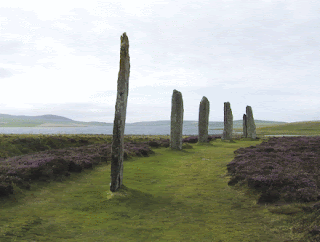Stonehenge, showing one of the 'gallows-like' structures
What's in a name?
Why is Stonehenge called 'Stonehenge'? Like almost everything else about it, Stonehenge's name is a little ambiguous. Almost all of the etymologies suggest it derives from the Old English stan meaning 'stone'. The 'henge' may come from hencg meaning 'hinge', or hencen meaning 'gallows' or 'hanging place'. It is not clear if they were actually using the stones to hang people from, or whether they simply thought that the stones resembled a gallows.
Archaeology took the word 'henge', and used it to define a monument that is circular or ovular, with a ditch and bank structure, and the ditch on the inside, the opposite of a defencive structure. All well and good; we needed a word to describe those pesky circles. Except... Stonehenge doesn't have an internal ditch, and it's bank is pretty pathetic: only about 1m high. So actually, it's not a henge.
Avebury, which has an actual henge surrounding the stone circles.
It's also, and this is the mind blowing part, not made of stone.
Okay, it is actually stone, but it almost certainly symbolically represents wood, rather than stone. It doesn't look like any other stone circle. Normal stone circles do not have connecting stones on top of the uprights, but this is thought to have been very common in timber circles. Below is a picture of the Stones of Stenness, a 'more typical' stone circle, and a reconstruction of a timber circle.
Which one looks more like Stonehenge?
The way the lintel (top) stones are attached is also by a method far more suited to woodworking than stone building. Above is a close up of one of the standing stones. See the little bump on the top? That's to attach the lintel stone, which would have a corresponding hole gouged into it. This is still used in Ikea furniture.
Archaeologists have started to think about Stonehenge in the context of timber, rather than stone circles. A good place to start, if you're interested, is Stonehenge and other Timber Circles by Alex Gibson.
Who built Stonehenge?
A wizard did it. No, really. Geoffrey of Monmouth in the 12th Century wrote an account of the building of Stonehenge. By Merlin.
Not that Merlin. The proper one. Here's a picture of him directing some giants to help him build Stonehenge.
This is the oldest known depiction of Stonehenge.
A bit later on, in the 1600s, a man called William Stukeley had some other ideas about Stonehenge. Stukeley was one of the most important fore-runners to modern archaeology, who drew some brilliant pictures of the monuments, and did quite a bit of 'excavating'. This was closer to Time Team's methods than a real archaeological enquiry, but pioneering for the time. He was also one of the first biographers of Newton, who was a personal friend. Stukeley suggested that it might have been built by the Druids. This isn't as mad as it first sounds: he identified the building as ritualistic in nature, and then looked for a corresponding 'Priestly-caste' in the ancient sources for a people who had lived here before the Romans. The priests he found were the Druids. Druids became quite popular at one time as folk heroes: those Celtic people who had fought the Romans. This was important, because most of the folk heroes of the individual countries of Great Britain were heroes for killing the others. Usually the English.
More recently, thanks to various dating methods, it has become clear that Stonehenge is much, much older than the Druids.* They existed about 2000 years ago, all across Western Europe. By AD86 they had been herded across Europe by the Romans. Agricola, the governor of Britain cornered the last of them on Anglesy and had them all killed.
However, Stonehenge had been built long before that, from about 3100BC - 1600BC, in a series of very distinct phases. Clearly the place was important, but it's meaning would almost certainly have changed over that time. Since we think the average life expectancy was about 30, that's 3 generations a century, or 45 generations in total. That's more than the generations between our time and the time of Jesus.
What does it mean?
No one knows. Is it, as Mike Parker Pearson has suggested, a place that represents death? Would people have processed from Woodhenge (a timber circle), the symbolic place of life to Stonehenge, the symbolic counterpart? Or does it represent life, as a timber circle, immortalised forever as durable stone? Is it a landing place for aliens, an inter dimensional portal, a prehistoric computer?
Jaquetta Hawkes said that 'Every generation gets the Stonehenge it deserves', by which she meant that each new group of archaeologists has a new take on the meaning of the monument, usually at least in part driven by their own ideas about the world.
What Stonehenge meant to the people who built it is likely to be something archaeologists argue about forever, and probably something we will never really know. However, Stonehenge is more than just a dead monument; it has meaning to people in the here and now. In that case, Stonehenge can mean anything you want it to; Stonehenge can be all things to all people, as long as they don't extrapolate that back onto those in the past.
*Note: the Neo-Druids contest this; they continue to believe that Stonehenge was built by Druids.







why do people care so much about this site?
ReplyDelete